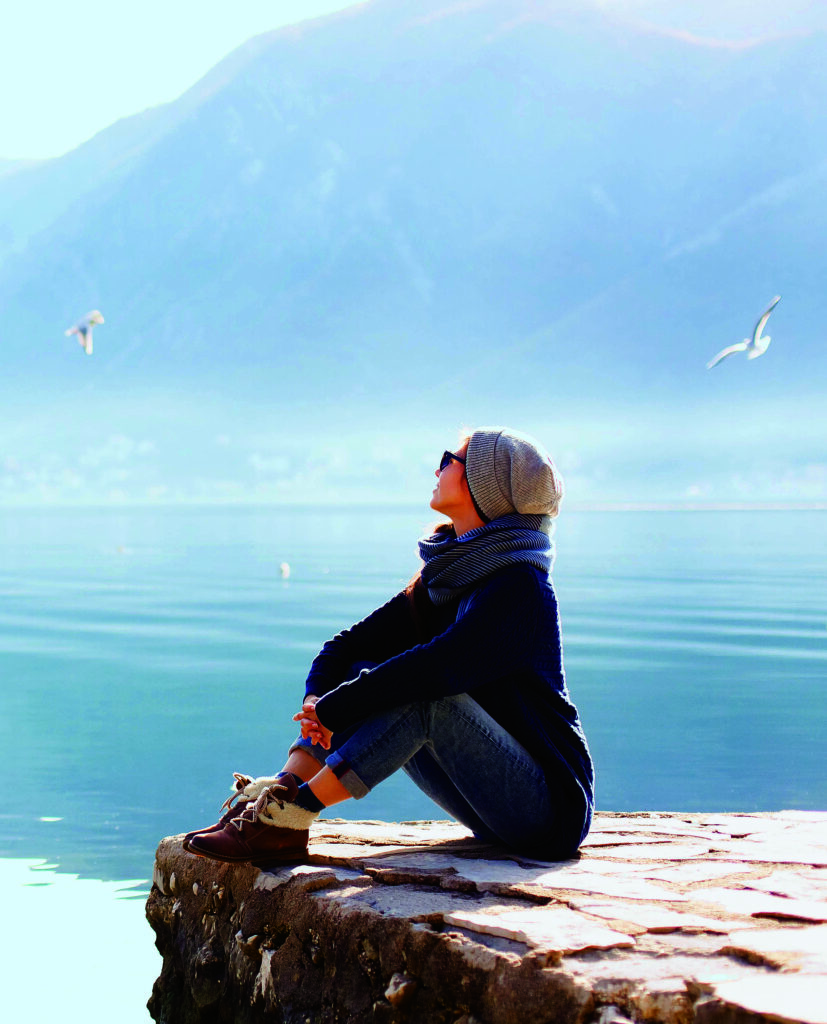“Hope is the thing with feathers That perches in the soul, And sings the tune without
the words, And never stops at all…”
By Anne Kaiser
The first stanza of this 1861 poem by Emily Dickinson is familiar to many; its uplifting lyric verse, though written in a past era, carries a bright and abiding message applicable even in today’s world.
Now more than ever, people throughout our country and the world must navigate both global challenges and personal concerns. Whether we face economic, environmental, political, or health upheavals, perseverance and hope remain, drawing diverse populations toward common goals and renewed resolve.
Hope appears at different times and in varied forms, sometimes clearly, other times, in unexpected or surprising ways. Whether we receive a heartfelt holiday greeting from a childhood friend, believe in the healing power of the human body and spirit against all odds, or discover autumn’s final wildflowers, hope infuses life’s fabric with a golden thread of possibility, even in the face of hardship and doubt.
As we enter this time of light and spiritual warmth, we call once again upon the power and support of community, friends, and family with renewed hope that joy might touch, bless and heal.

Like its spiritual counterpart hope, faith also knits a fabric of warmth, connection and sustenance. When we tap into forces of the spirit greater than the individual self, our hearts and minds connect to a wellspring of possibility, hope and joy. Communities bolstered by a sense of faith engage their members with celebrations, rituals, and rites of passage that unite, fortify and inspire.
Our lives and celebrations of faith exist within the fabric of the larger natural world. Nature inspires us through its ever-present ability to regenerate and heal. As its annual seasons unfold, nature undergoes a continuous cycle of growth and dormancy, an ebb and flow of energy as ancient and reassuring as time itself. Here in Wisconsin, we are fortunate to witness the annual cycle of four distinct seasons, each with unique gifts.
When winter blankets the Wisconsin landscape, candles and holiday lights create an arc of sparkling days, extending precious hours of light even in the depth of winter’s darkness. Many cultures include celebrations of light at this time of year. We follow the natural cycle of the season, move indoors, turn inward in contemplation as we prepare to bid farewell to the year past and to usher in a new year. To counterbalance moments of solitude and reflection, we gather with family and friends at the holidays, or share acts of kindness and celebration with the larger community.
Some families bring evergreen trees, holly or poinsettias into their homes, or choose to honor this peaceful time with other spiritual, seasonal rituals. Evergreens offer tangible natural reminders of hope and faith kept alive in the midst of this chilly season of stillness and rest.
Just as evergreens remind us of life’s tenacity, hope arrives in our lives in ways both minute and grand, and often when it is most needed. Nature provides year-round solace to many, and time spent simply absorbing the beauty provided by trees and flowers around a home or in a neighborhood can bolster the spirit, offering renewal throughout the year. In this season, the stillness of Wisconsin’s first snowfalls settles over the now-dormant landscape. Squirrels nestle high in the crooks of tree branches, munching prized walnuts, and cardinals and sparrows frequent birdfeeders in noisy, chattering flocks.
Time spent in nature can provide a nourishing connection to our spiritual selves, even our chosen faiths. Neighborhood walks, whether solitary or shared with friends or family, can enliven a sense of hope and possibility in the spirit throughout the seasons.
Nature’s gifts unfold in a shifting canvas of becoming, available for all, whether viewed through a window from the warmth of home or in person. Spring ushers in the first noble crocuses and forsythia bright as captured sunlight; summer welcomes resplendent
peonies and shifting patterns of light and leaf shadows on the earth; autumn heralds purple asters and a stunning palette of sumac, ash, and maple leaves. Winter—that quieter season of stillness and waiting—brings patches of glass-thin ice dappled a filigree of snow, and the happy calls of chickadees on crisp, sun-touched mornings.
Nature speaks a language that transcends human differences and challenges, knitting individuals and their communities together, holding metaphors of transformation and growth that provide a spiritual tether for many. Literary works that describe the natural world offer inspiring glimpses into nature’s power to survive and transcend in regions close to home or farther afield.
For example, humble mosses carry messages of adaptability and endurance. Found nearby in forests, our backyards, or tucked within the slim cracks in sidewalks, mosses seem familiar, and we might not initially pause to consider their unique qualities. But a closer look at these masters of survival—there are at least 22,000 species of moss spread throughout most of
Earth’s ecosystems—remind us of the living presence of hope close to home.
Author Robin Wall Kimmerer, a scientist, professor, and 2022 MacArthur Fellow, examines the lives and adaptations of diverse mosses through a series of essays both scientific and lyrical in her award-winning book, Gathering Moss: A Natural and Cultural History of Mosses. Many mosses embody a quality of hope, growing in miniature on surfaces and surviving periods of desiccation to return to vibrant green. The growth patterns of these small life forms help to remind us of our own tenacity and persistence through difficulty.
Further afield from Wisconsin, along the Atlantic coast of the southern United States, the sabal palm offers another living example of hope. This palm emerges from a blueberry-like seed that must first survive months afloat in salty ocean water before arriving ashore to germinate. The emergent palm must survive fluctuating periods of moisture and drought, saltwater, and lightning, and once it begins to grow, burrows down into the ground before turning upward to emerge. Surprisingly, this period of growth can last around sixty years. Professor and acclaimed author David George Haskell illuminates the inspirational growth
patterns of the sabal palm and a selection of other trees around the world in his 2017 written melding of science and poetry, The Songs of Trees: Stories from Nature’s Great Connectors.
Just as nature inspired Emily Dickinson as she envisioned and personified hope as a bird, nature continues to propel contemporary individuals toward community betterment and care of the environment. Acts of care for nature in turn nourish and rejuvenate the human spirit.
One such well-known visionary who has worked tirelessly caring for the natural environment and its animal and human communities—Jane Goodall—shares her insights about these topics and her overarching belief in hope in the 2021 book with Douglas Abrams and Gail Hudson, The Book of Hope: a Survival Guide for Trying Times.
In this text, Douglas Abrams captures his conversations with Goodall, and delivers to readers abundant examples of persistence, vision, hope and faith. Examples of individuals’ courage and hope-building community programs like Goodall’s Roots and Shoots all inspire, touching upon the tenacity and strength of the human spirit in communities around the world. Goodall’s vision of hope is active, catalyzing readers to put belief into action.
Goodall shares the story of two men in rural China, Jia Haixia and Jia Wenqi, friends who encountered hardship yet rose above their challenges to facilitate good in their community. One had lost both arms in an accident as a child, and the other had become completely blind in his mid-thirties. When this occurred, he sank into a depression. Seeing this, his friend devised a plan to uplift his blind friend’s spirit. The two men embarked on a mission to plant cuttings for young trees to help revitalize the polluted land around their village. One served as the eyes for the other, who used his hands to help plant the trees.
A remarkable story ensued. The two men persisted when only two of their initial planting of 800 cuttings survived, and went on to successfully plant over 10,000 trees. Jane Goodall shares a quote from Jia Wenqi, the man without arms: “‘Though we are limited physically, our spirit is limitless. So let the generations after us, and everyone else, see what two handicapped individuals have accomplished. Even after we’re gone, they will see that a blind man and an armless man have left them a forest.’”
This example of human spiritual healing intertwined with nature-based regeneration and growth serves as an important reminder of the presence of hope and faith in the world all around us. Nature’s life and new growth emerge readily when provided optimal conditions. So, too, the human spirit moves without encumbrance when nurtured and offered opportunity.
Hope bolsters faith; the two are interwoven in a supportive network of positive energy. Along with love, that powerful energy of connection and joy, the transformative beauty of the natural world connects, guides, and inspires individuals and communities throughout the seasons.

This article is from the
EY December 2022 Issue


